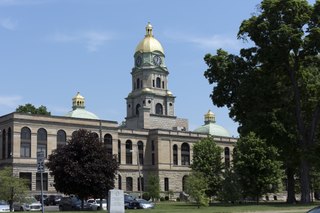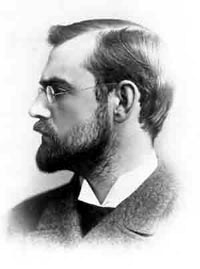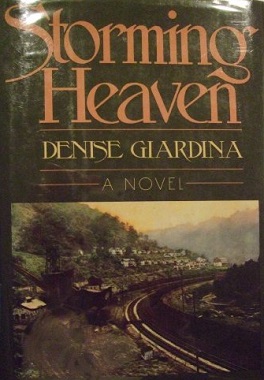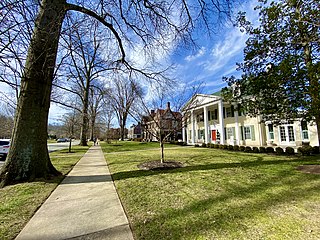
Cabell County is a county located in the U.S. state of West Virginia. As of the 2020 census, the population was 94,350, making it West Virginia's fourth most-populous county. Its county seat is Huntington. The county was organized in 1809 and named for William H. Cabell, the Governor of Virginia from 1805 to 1808. Cabell County is part of the Huntington–Ashland, WV–KY–OH Metropolitan Statistical Area.

Huntington is a city in Cabell and Wayne counties in the U.S. state of West Virginia. The seat of Cabell County, the city is located at the confluence of the Ohio and Guyandotte rivers in the state's southwestern region. The population was 46,842 at the 2020 census, and was estimated to be 45,325 in 2023. Huntington is the second-most populous city in West Virginia. The Huntington–Ashland metropolitan area, spanning seven counties across West Virginia, Kentucky and Ohio, had an estimated population of 368,262 in 2023.

Collis Potter Huntington was an American industrialist and railway magnate. He was one of the Big Four of western railroading who invested in Theodore Judah's idea to build the Central Pacific Railroad as part of the first U.S. transcontinental railroad. Huntington helped lead and develop other major interstate lines, such as the Southern Pacific Railroad and the Chesapeake & Ohio Railway (C&O), which he was recruited to help complete. The C&O, completed in 1873, fulfilled a long-held dream of Virginians of a rail link from the James River at Richmond to the Ohio River Valley. The new railroad facilities adjacent to the river there resulted in expansion of the former small town of Guyandotte, West Virginia into part of a new city which was named Huntington in his honor.

The Teays River (pronounced taze) was a major preglacial river that drained much of the present Ohio River watershed, but took a more northerly downstream course. Traces of the Teays across northern Ohio and Indiana are represented by a network of river valleys. The largest still existing contributor to the former Teays River is the Kanawha River in West Virginia, which is itself an extension of the New River. The name "Teays," from the much smaller Teays Valley still extant above the surface, has been associated with the river and the remainder of its related buried valley since 1910. The more appropriate name would be the Ancestral Kanawha Valley. The term Teays is used when discussing the buried portion of the Ancestral Kanawha River. The Teays was comparable in size to the Ohio River. The River's headwaters were near Blowing Rock, North Carolina; it then flowed through Virginia, West Virginia, Ohio, Indiana, and Illinois.. The largest tributary to the Teays River was the Old Kentucky River, which extended from southern Kentucky through Frankfort and subsequently flowed northeast, meeting other tributaries and eventually joining the Teays.

The Chesapeake and Ohio Railway was a Class I railroad formed in 1869 in Virginia from several smaller Virginia railroads begun in the 19th century. Led by industrialist Collis P. Huntington, it reached from Virginia's capital city of Richmond to the Ohio River by 1873, where the railroad town of Huntington, West Virginia, was named for him.

WOWK-TV is a television station licensed to Huntington, West Virginia, United States, serving the Charleston–Huntington market as an affiliate of CBS. Owned by Nexstar Media Group, the station maintains studios on Quarrier Street near the Charleston Town Center in downtown Charleston, and its transmitter is located in Milton, West Virginia.

Archer Milton Huntington was an American philanthropist and scholar, primarily known for his contributions to the field of Hispanic studies. He founded the Hispanic Society of America in New York City, and made numerous contributions to the American Geographical Society.

State Route 7 (SR 7), formerly known as Inter-county Highway 7 until 1921 and State Highway 7 in 1922, is a north–south state highway in the southern and eastern portions of the U.S. state of Ohio. At about 336 miles (541 km) in length, it is the longest state route in Ohio. Its southern terminus is an interchange with U.S. Route 52 (US 52) just west of Chesapeake. Its northern terminus also serves as the eastern terminus of SR 531 in Conneaut. The path of SR 7 stays within five miles (8.0 km) of the Ohio River for the southern portion, with the river being visible from much of the route. The road also remains within 10 miles (16 km) of the Pennsylvania state line for the northern portion.

WKEE-FM is a contemporary hit radio formatted broadcast radio station licensed to Huntington, West Virginia, serving Huntington, West Virginia, Ashland, Kentucky, and Ironton, Ohio. WKEE-FM is owned and operated by iHeartMedia. WKEE-FM is the heritage CHR/Top 40 station in the Huntington area, having programmed hit music as a standalone FM for over 30 years.

East Lynn Lake is a 1,005-acre (4 km2) reservoir on the East Fork Twelvepole Creek in Wayne County, West Virginia. The lake is operated by the U.S. Army Corps of Engineers, Huntington District, as part of a series of flood control projects for the Ohio River basin.
The Huntington–Ashland metropolitan area is a metropolitan area in the Appalachian Plateau region of the United States. Referred to locally as the "Tri-State area," and colloquially as "Kyova", the region spans seven counties in the three states of Kentucky, Ohio, and West Virginia. With a population of 361,580, the Tri-State area is nestled along the banks of the Ohio River. The region offers a diverse range of outdoor activities.

William Elmer Neal was a physician and U.S. Representative from West Virginia.

Storming Heaven is Denise Giardina's second novel. It was published in 1987 and won the W.D. Weatherford Award that year. It is a fictionalized account of the labor strife in the coalfields of southern West Virginia, United States during 1920 and 1921. It mainly takes place in the town of Annadel, which is based on the town of Keystone, West Virginia. Its events also have similarities to the Ludlow Massacre, which is mentioned in the book.

The Clover site (46CB40) is a Fort Ancient culture archeological site located near Lesage in Cabell County, West Virginia, United States. It is significant for its well-preserved remains of a late prehistoric/protohistoric Native American village. The site's unique assemblage has made it the type site for the Clover Phase of the Madisonville horizon of the Fort Ancient culture.

Huntington is the surname of three prominent families from the United States of America. The first was active in the eastern region; the second played an important role in the early Latter Day Saint movement, and pioneered and founded the State of Utah with Brigham Young; the third was active on both coasts and the regions linking them. All three lines descend from Simon Huntington and his wife, Margaret Baret Huntington, who immigrated to America from Norwich, England, in 1633.

The Beeches, also known as the Huntington-Skinner House and Woman's Club of St. Albans, is a historic home located at St. Albans, West Virginia. It was built about 1874 for Henry Edwards Huntington in the Italianate style. After its purchase in 1903 by locale magnate J. V. R. Skinner, the two story home was transformed with a mix of formal interior and exterior details and additions. It commands an excellent view of Kanawha Terrace, a principal street of St. Albans, atop a hill that descends in a gentle slope shaded with trees and shrubbery.

Ritter Park Historic District is a national historic district located at Huntington, West Virginia. The district encompasses 68 contributing buildings and 5 contributing structures, including the Ritter Park municipal park. The city purchased the park property in 1908. Dwellings in the district represent the finest styles in popular architecture from the years 1913 to 1940, including Colonial Revival, Bungalow/craftsman, and Tudor Revival.
Paul Thomas Farrell Jr. is an American attorney from Huntington, West Virginia who ran for President of the United States in the 2016 West Virginia Democratic primary.


















